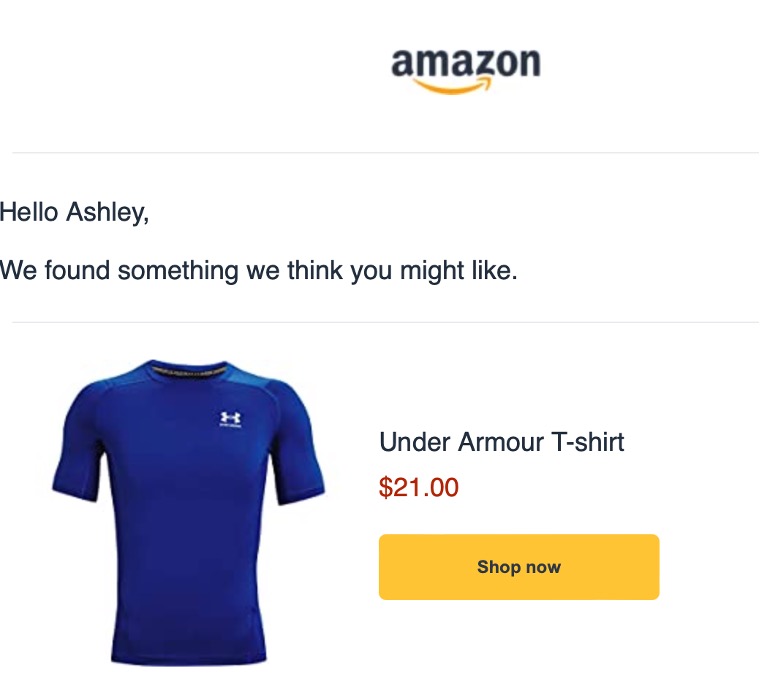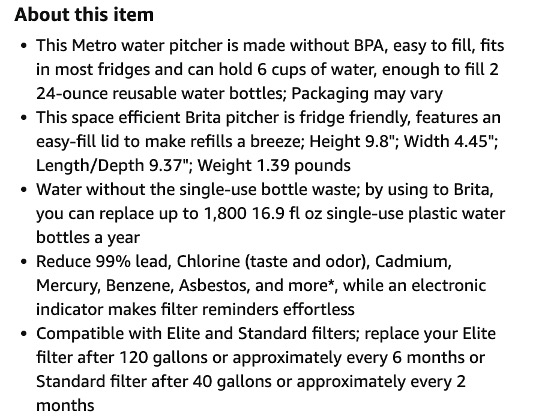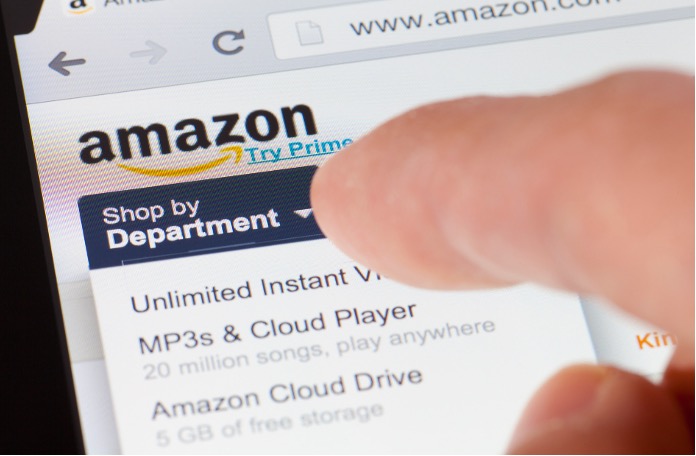Amazon
Business Marketing Strategy
The hallmarks of Amazon business marketing strategy are, convenience, product personalization, product recommendations, and above all, an enhanced customer experience.
Amazon's amazing and convenient e-commerce platform is known for its vast array of products, affordable prices and timely delivery. It is used by millions of people around the world today, and has come a long way since launching in 1994.
I fell in love with Amazon because of its intuitive user-friendly interface, its product rating and honest customer reviews which improves my decision making, not to mention its service, of course!

The idea of shopping for any product from home furnishing to decorations to tech devices to even clothes without having to leave my house is such a huge convenience for me.
The updates I receive each time I place an order always gives me a sense of confidence and trust in its delivery service. Upon delivery of my items, I always receive an email asking if my product expectations were met with the option to write a review.
This shows that Amazon cares about my experience and wants to ensure that I’m satisfied with my purchase.
Amazon business marketing strategy involves making the customer experience as smooth and efficient as possible by going way and above for its customers. Enhancing its customer experience is what accounts for its success.
Let’s Take a Look at 5 Top Reasons Why Amazon is an
Ecommerce Hit

1. The Marketing is Aligned with Customers’ Interests
Amazon greets its customers by name on its website and emails. Products that are aligned with customers’ interests are often recommended in its emails to customers.
Product recommendations are based on past purchases, product searches and even products added to customers’ wish lists.
This strategy encourages increased customer traffic to its website, awareness of its various products and services together with repeat purchases. Therefore, these well thought out features allow me to enjoy my browsing and shopping experience to the fullest!


2. Data
Amazon business marketing strategy is centered around data. The data is used to manage how the content is displayed to various users such as new releases, top -sellers, product promotions and paid search advertising.
Data is a major part of Amazon's content strategy, like the secret ingredient to a gourmet dish.
This is how Amazon is able to make personalised product recommendations and messages where customers are asked to rate their transactions or even state if they’re pleased with their purchase.
Amazon records data on everything!
From customer's searches to items bought and pages viewed. This data recording helps with developing top-tier cross selling strategies.
If you love your discounts and specials on "frequently bought together" items, this is courtesy Amazon data collection.

3. SEO
Amazon assigns high demand and relevant keywords to its products. These keywords are placed within the product title, description and even sponsored product ads. is what draws customers in as Amazon displays content that’s aligned with what customers are searching for.
SEO is what drives consistent traffic to the various product pages where Amazon’s aim is to meet the product demand of its customers.


4. Promotional and Pricing Strategies
The promotional and pricing strategies both play huge roles in the Amazon business marketing strategy. Amazon uses its online channels to execute its promotional strategy with the aim of directing its customers to its website.
These online channels include the Associates program. Have you ever noticed on a YouTube video when someone talks about some amazing books they've been reading or some gadget they're using and they share a link to these items with their audience?
That’s how they earn commission through the associates program.

Amazon offers discounts, coupons, prime subscription with free shipping offers on eligible items as a way of driving repeat purchases. This is basically a strategy aimed at encouraging its customers to take advantage of these affordable deals.
Free shipping offers and Amazon prime are Amazon’s marketing tools that have proven to be successful internationally. Part of amazon business marketing strategy is to continue to provide these options to its customers for a very long time which pretty much makes good business sense.
After all, it’s what helps makes its strategy successful.


5. Technology
Amazon uses technology to bring its vision and strategy to life. Seamless processes and systems definitely help to build customer trust!
Its technology infrastructure is designed to facilitate its seamless processes and systems. This involves accepting and confirming customers’ orders, placing and tracking orders with the suppliers, inventory management plus securing accurate shipment of products to its customers.
Its transaction processing systems are designed to facilitate millions of orders from customers, several order statuses queries, numerous shipping addresses, customers’ requests and several shipping methods.
These systems provide customers with the options to select one or many shipments depending on the availability. Customers are also able to track the status of their orders which is a very important part of the entire customer experience.
Amazon business marketing strategy involves the use of technology to ensure proper distribution and deployment of products to its customers. Its technology infrastructure helps to execute its distribution strategy.
This is reflected in its comprehensive processes beginning with the purchase of items straight to delivery to its customers.
The applications used by Amazon are designed to effectively manage credit card payments that involves accepting, validating and charging customer credit cards. Amazon’s strategy is about leveraging technology to earn customer trust and confidence.
Innovative Examples of Amazon Business
Marketing Strategy

Amazon Prime
Amazon Prime facilitates fast and free shipping that comes with a monthly subscription fee after a free trial use. This provides value for money where customers receive their items in 2 days and are eligible for exclusive and prime early access sale among other services.
Purchases with Just One-Click
This prevents the hassle of completing a form when making a purchase. It’s convenient and simple which is aligned with Amazon business marketing strategy.

Kindle
Amazon Kindle is quite a simple and affordable way to get books. Amazon’s share of the eBook market is roughly 67% where it’s positioned as one of the largest sellers of eBooks.

Alexa
Amazon Alexa is a form of virtual assistant technology. It enables voice interaction, music selection, weather and traffic updates, news in real time, sports and setting to do lists.
Amazon business marketing strategy is heavily facilitated by its technology infrastructure designed to provide timely delivery and efficient customer service. It’s transition from its early days in Jeff Bezos’s garage to becoming one of the largest e-commerce companies in the world is quite admirable.
Amazon announced back in April 2022 its intention to invest $1 billion to facilitate and promote innovation in supply chain and logistics. The purpose of this huge investment is to continuously enhance the customer and employee experience.
2024 update:
Drone Delivery Service
Amazon was granted approval to expand its drone delivery program, allowing the company's Prime Air service to operate drones "beyond visual line of sight." This approval also applies to College Station, Texas U.S. to facilitate the remote operation of drones without any direct visual contact.
Amazon plans to expand its operations in College Station to serve more densely populated areas. Additionally, its objective is to expand drone deliveries across the U.S.
This innovative tactic comes after Amazon developed a strategy for drones to minimise any drawbacks and its execution of successful flight demonstrations with real aircraft. Amazon aims to deliver 500 million packages by drone annually by the end of the decade.
Commitment to Delivering Quality Items
Amazon's Project P.I. is revolutionizing how products are handled in their fulfillment centers by using AI technology to ensure customers receive items in excellent condition.
This AI model is an efficient investigator, where it scans millions of products daily, detecting any defect such as damage or incorrect sizing before they reach customers. By preventing the delivery of defective or faulty items, Amazon not only enhances customer satisfaction but also supports sustainability efforts by minimising waste via returns and excess packaging.
Also, Amazon leverages generative AI to analyse and prevent errors, improving the entire customer experience and helping independent sellers manage any issues in a timely manner.
This initiative is part of Amazon's overall strategy to integrate AI with the aim to enhance the customer experience and adopt an environmentally friendly approach. As AI technology continues to evolve, Amazon aims to fully cater to its customers and support sustainability by innovating as much as possible.
Amazon business marketing strategy reflects its commitment to continuously enhancing the customer experience by leveraging its technology infrastructure. Its tremendous growth over a span of two decades proves that continuously investing in the latest technology to deliver the best customer experience is the key to success!
- Marketing
- Good Marketing Strategies
- Amazon Business Marketing Strategy